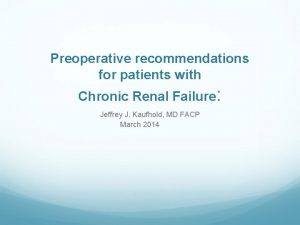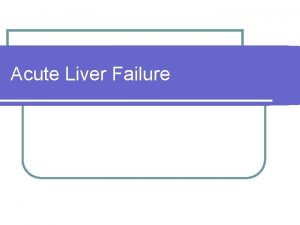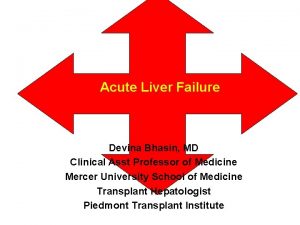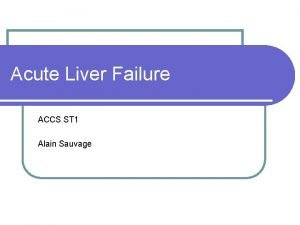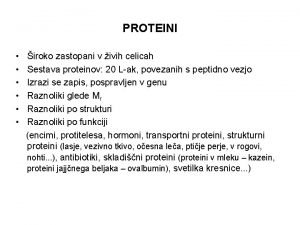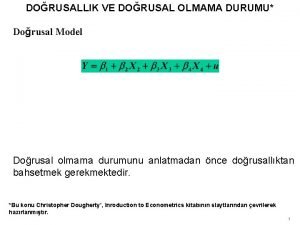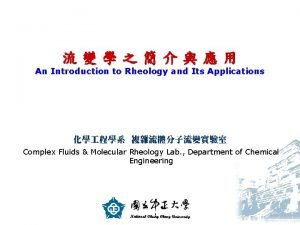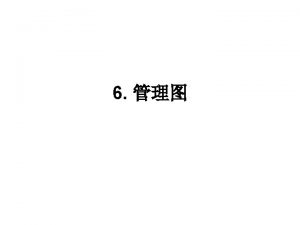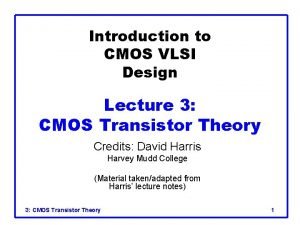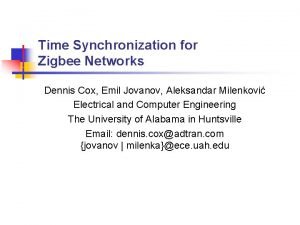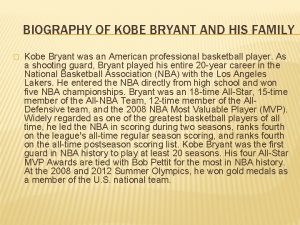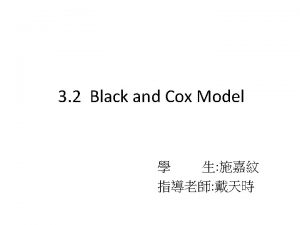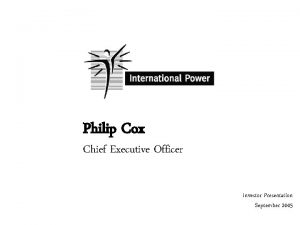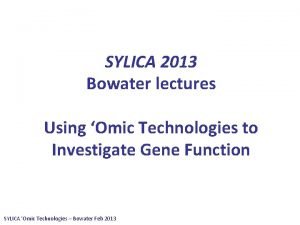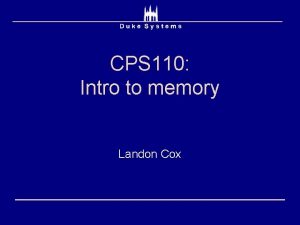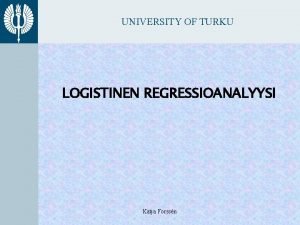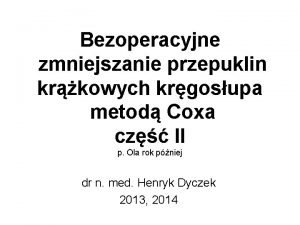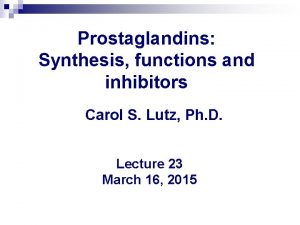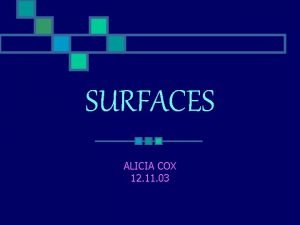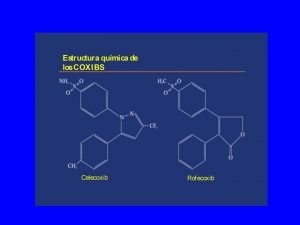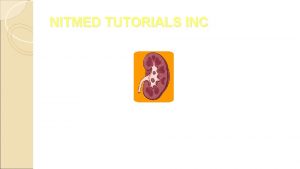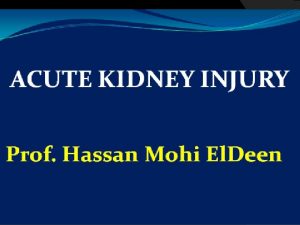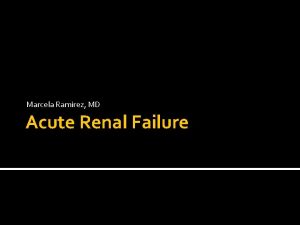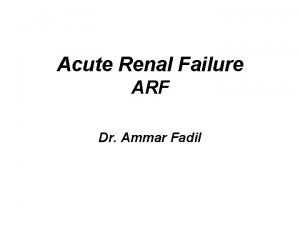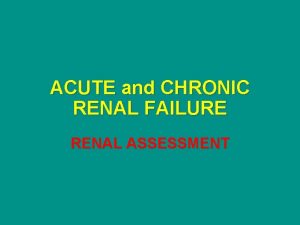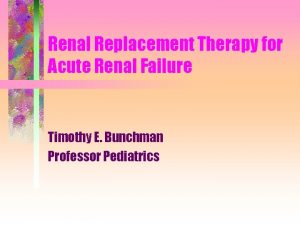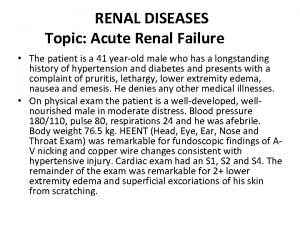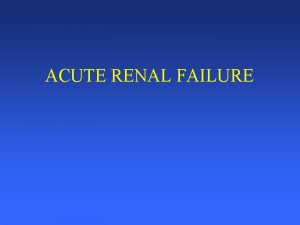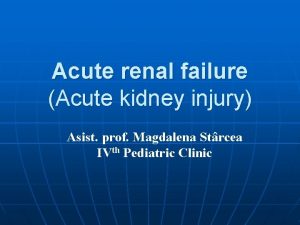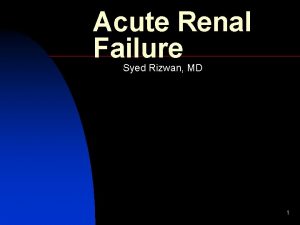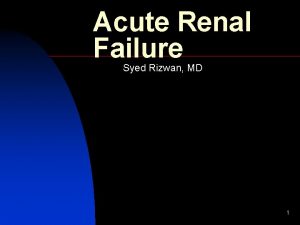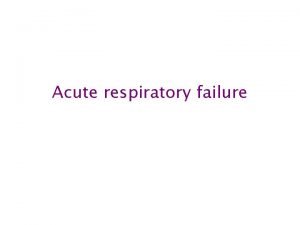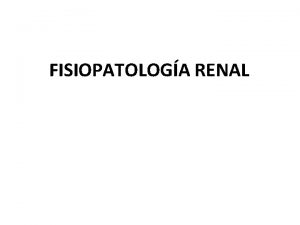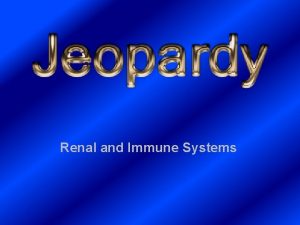Acute Renal Failure Malcolm Cox M D Acute












































- Slides: 44

Acute Renal Failure Malcolm Cox, M. D.

Acute Renal Failure Definition • Acute decrement in GFR • May heal partially or completely or progress to more severe renal insufficiency, including end -stage renal disease

Review 9. 0 Serum Creatinine (mg/dl) 8. 0 7. 0 6. 0 5. 0 4. 0 3. 0 2. 0 1. 0 0 0 20 40 60 80 100 120 140 160 180 Inulin Clearance (ml/min per 1. 73 m 2)

Acute Renal Failure Classification • Pre-renal (functional) • Renal (structural) • Post-renal (obstruction)

Acute Renal Failure Pre-renal Causes • Intravascular volume depletion – Hemorrhage – Sodium depletion • Redistribution of ECF – “Third space” accumulation – Edematous disorders • Drugs

Review Renal Blood Flow F = P/R RAP – RVP RBF = Raff + Reff RBF ~ RAP Raff + Reff

Review Raff RAP Reff PGC

Pre-Renal Azotemia Pathophysiology • Renal hypoperfusion – Decreased RBF and GFR – Increased filtration fraction (GFR/RBF) • Increased Na and H 2 O reabsorption – Oliguria, high Uosm, low UNa – Elevated BUN/Cr ratio

Acute Tubular Necrosis Classification • Ischemic • Nephrotoxic

Acute Tubular Necrosis

Acute Tubular Necrosis

Acute Renal Failure Nephrotoxic ATN • Endogenous Toxins – Heme pigments (myoglobin, hemoglobin) – Myeloma light chains • Exogenous Toxins – – Antibiotics (e. g. , aminoglycosides, amphotericin B) Radiocontrast agents Heavy metals (e. g. , cis-platinum, mercury) Poisons (e. g. , ethylene glycol)

Acute Tubular Necrosis

Acute Tubular Necrosis

Acute Interstitial Nephritis Causes • Allergic interstitial nephritis – Drugs • Infections – Bacterial – Viral • Sarcoidosis

Allergic Interstitial Nephritis Clinical Characteristics • • • Fever Rash Arthralgias Eosinophilia Urinalysis – Microscopic hematuria – Sterile pyuria – Eosinophiluria

Acute Interstitial Nephritis

Cholesterol Embolization

Contrast-Induced ARF Prevalence • Less than 1% in patients with normal renal function • Increases significantly with renal insufficiency

Contrast-Induced ARF Risk Factors • • • Renal insufficiency Diabetes mellitus Multiple myeloma High osmolar (ionic) contrast media Contrast medium volume

Contrast-induced ARF Clinical Characteristics • • • Onset - 24 to 48 hrs after exposure Duration - 5 to 7 days Non-oliguric (majority) Dialysis - rarely needed Urinary sediment - variable Low fractional excretion of Na

Contrast-induced ARF Prophylactic Strategies • • • Use I. V. contrast only when necessary Hydration Minimize contrast volume Low-osmolar (nonionic) contrast media N-acetylcysteine, fenoldopam

Acute Renal Failure Post-renal Causes • Intra-renal Obstruction – Acute uric acid nephropathy – Drugs (e. g. , acyclovir) • Extra-renal Obstruction – Renal pelvis or ureter (e. g. , stones, clots, tumors, papillary necrosis, retroperitoneal fibrosis) – Bladder (e. g. , BPH, neuropathic bladder) – Urethra (e. g. , stricture)

Acute Renal Failure Diagnostic Tools • Urinary sediment • Urinary indices – Urine volume – Urine electrolytes • Radiologic studies

Urinary Sediment (1) • Bland – Pre-renal azotemia – Urinary outlet obstruction

Urinary Sediment (2) • RBC casts or dysmorphic RBCs – Acute glomerulonephritis – Small vessel vasculitis

Red Blood Cell Cast

Red Blood Cells Monomorphic Dysmorphic

Dysmorphic Red Blood Cells

Dysmorphic Red Blood Cells

Urinary Sediment (3) • WBC Cells and WBC Casts – Acute interstitial nephritis – Acute pyelonephritis

White Blood Cells

White Blood Cell Cast

Urinary Sediment (4) • RTE cells, RTE cell casts, pigmented granular (“muddy brown”) casts – Acute tubular necrosis

Renal Tubular Epithelial Cell Cast

Pigmented Granular Casts

Acute Renal Failure Urine Volume (1) • Anuria (< 100 ml/24 h) – Acute bilateral arterial or venous occlusion – Bilateral cortical necrosis – Acute necrotizing glomerulonephritis – Obstruction (complete) – ATN (very rare)

Acute Renal Failure Urine Volume (2) • Oliguria (100 -500 ml/24 h) – Pre-renal azotemia – ATN • Non-Oliguria (> 500 ml/24 h) – ATN – Obstruction (partial)

Acute Tubular Necrosis Clinical Characteristics Characteristic Incidence Toxin-induced UV (ml/24 h) UNa (m. Eq/L) FENa (%) Dialysis required Mortality Oliguric ATN 41% 8% < 400 68 + 6 6. 8 + 1. 4 84% 50% Non-Oliguric ATN 59% 30% 1, 280 + 75 50 + 5 3. 1 + 0. 5 26% 25%

Acute Renal Failure Urinary Indices PR 500 ATN PR 40 ATN 40 1. 0 20 350 ATN UOsm (m. Osm/L) ATN 1. 0 20 ATN (U/P)Cr PR UNa (m. Eq/L) PR RFI PR FENa

Hydronephrosis

Normal Renal Ultrasound

Hydronephrosis

Hydronephrosis
 Ira pré renal renal e pós renal
Ira pré renal renal e pós renal Ira pré renal renal e pós renal
Ira pré renal renal e pós renal Treatments for acute renal failure
Treatments for acute renal failure Cortical and juxtamedullary nephrons difference
Cortical and juxtamedullary nephrons difference Renal failure
Renal failure Earthy look in chronic renal failure
Earthy look in chronic renal failure Azotemia
Azotemia Capture beat
Capture beat Failure to pace vs failure to capture
Failure to pace vs failure to capture Ductile vs brittle fracture surface
Ductile vs brittle fracture surface Transaminitis definition
Transaminitis definition Acute brain failure
Acute brain failure Acute liver failure criteria
Acute liver failure criteria Hepatic encephalopathy staging
Hepatic encephalopathy staging Acute vs chronic heart failure
Acute vs chronic heart failure Nelson and cox
Nelson and cox Box-cox dönüşümü
Box-cox dönüşümü An introduction to rheology
An introduction to rheology Efpractice
Efpractice Box cox minitab
Box cox minitab Cox webhosting
Cox webhosting Cox spam blocker
Cox spam blocker Remove furniture darwin
Remove furniture darwin Cox=eox/tox
Cox=eox/tox Jessica cox biografia
Jessica cox biografia Mpeg to jpeg
Mpeg to jpeg Klovenmodel
Klovenmodel Wash sector cox's bazar
Wash sector cox's bazar Cox emil
Cox emil Kobe bryant family facts
Kobe bryant family facts Cox.net
Cox.net Black and cox model
Black and cox model Cox investor relations
Cox investor relations Nele leosk
Nele leosk Nelson and cox
Nelson and cox Cox
Cox Alan cox rice
Alan cox rice Cox regression
Cox regression Vastemuuttuja
Vastemuuttuja Cox mill elementary school
Cox mill elementary school Metoda coxa
Metoda coxa Prostaglandins synthesized from
Prostaglandins synthesized from Alicia cox x
Alicia cox x Inhibidores selectivos de la cox-2
Inhibidores selectivos de la cox-2 Paul howat
Paul howat




